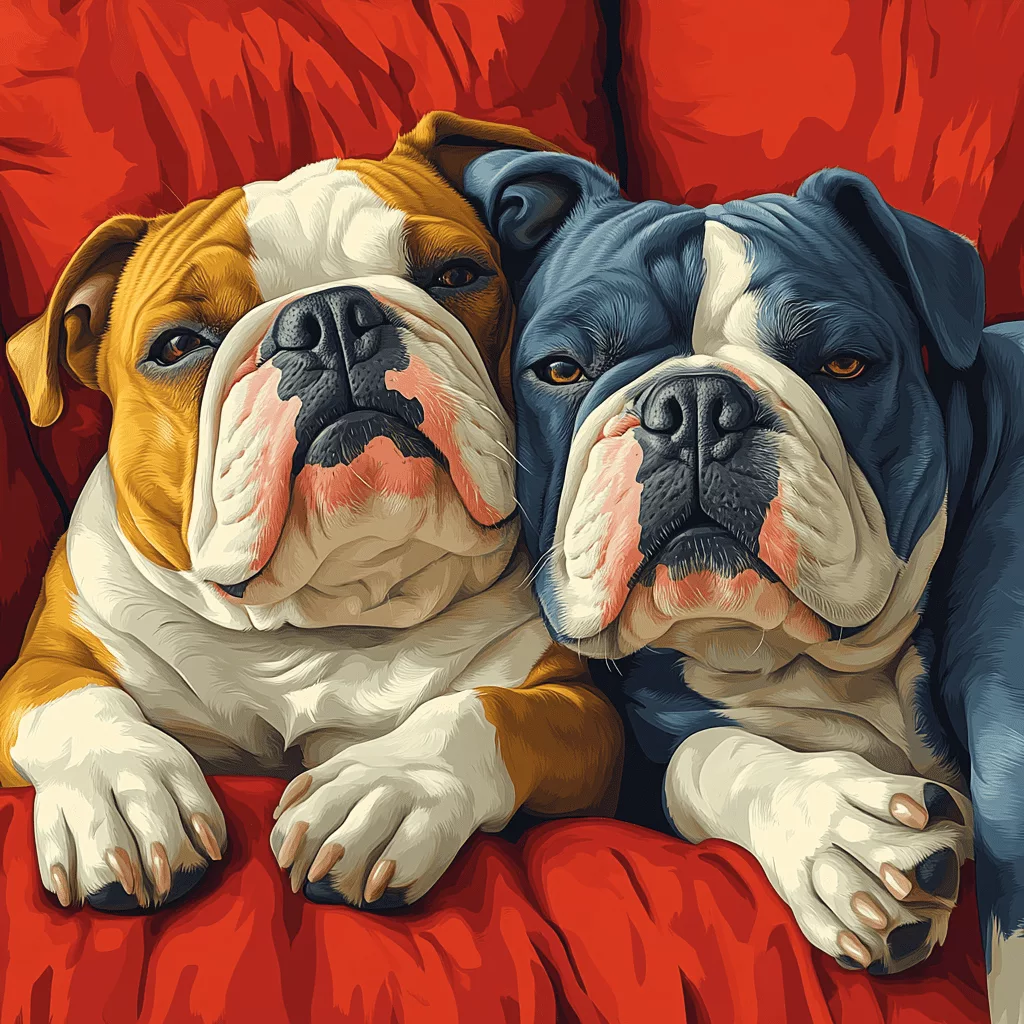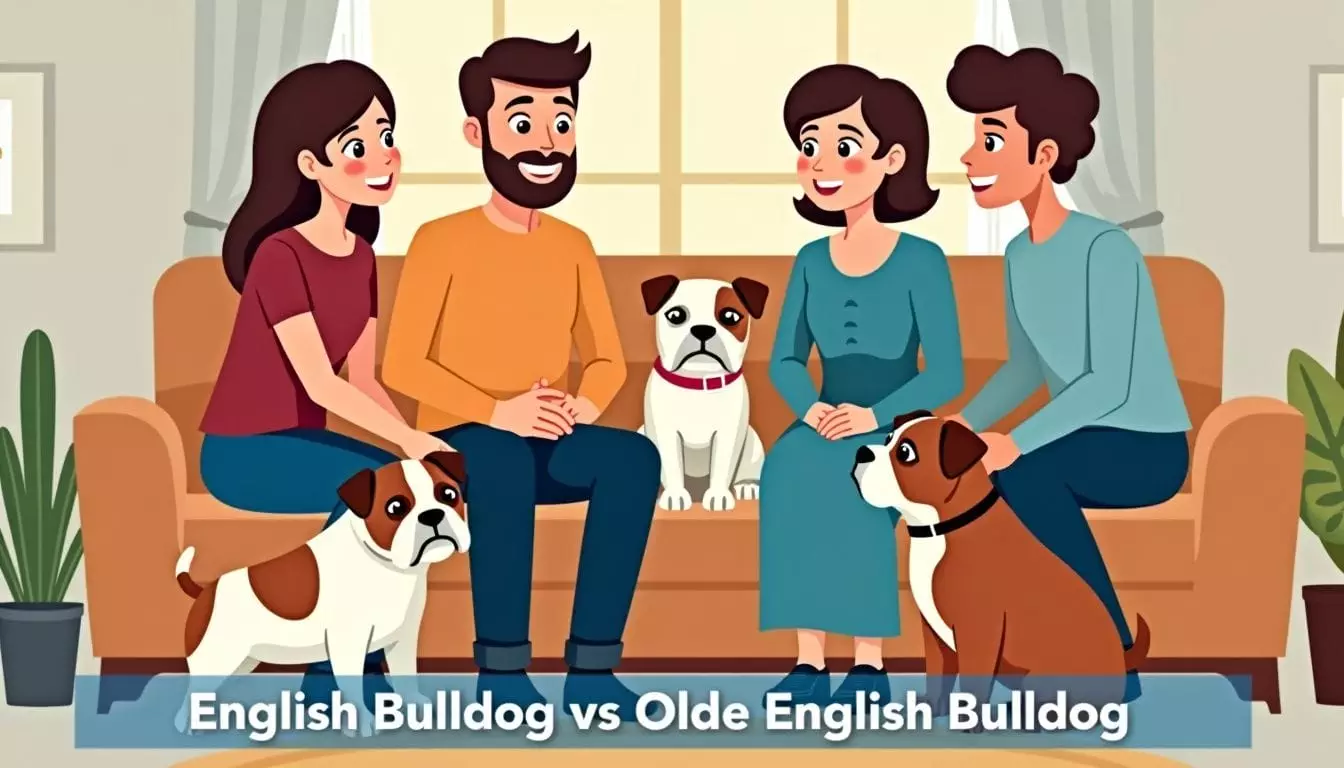Bulldogs capture hearts with their wrinkled faces and loyal nature. But did you know there’s more than one type? The English Bulldog vs Olde English Bulldog debate often confuses dog lovers.
These breeds differ in size, health, and origin. The English Bulldog traces back to 17th-century England, while the Olde English Bulldogge is a recent American creation. 2
Our team of vets and trainers brings you the facts on these two breeds. We’ll compare their looks, personalities, and care needs. You’ll learn which bulldog fits your lifestyle best. Additionally, we’ll discuss important dog breed characteristics such as exercise requirements, grooming needs, and potential health issues. By the end of our comparison, you’ll have a better understanding of whether the French Bulldog or the English Bulldog is the right fit for you and your family. Let’s dive in and explore the wonderful world of bulldogs!
Get ready to discover the unique traits of these lovable canines.
Key Takeaways
- English Bulldogs are smaller, weighing 40 to 50 pounds, while Olde English Bulldogges are larger at 60 to 80 pounds.
- Olde English Bulldogges live longer, 11 to 14 years, compared to English Bulldogs’ average of 7.2 years.
- English Bulldogs face more health issues, with 2.04 times higher risk of disorders than other dogs.
- Both breeds need about 15 minutes of play twice daily, but Olde English Bulldogges may need more exercise.
- English Bulldogs cost $1,500 to $4,000 to buy, while Olde English Bulldogges cost $2,000 to $5,000, with ongoing care costs for both.
Understanding the Breed Lineage: English Bulldog vs Olde English Bulldog

English Bulldogs and Olde English Bulldogs share a rich history. These breeds have distinct paths that led to their current forms.
Tracing the Historical Roots of the Bulldog Breeds
Bulldogs have a rich history dating back to 1210. 1 That year marked the start of bullbaiting in England. This cruel sport shaped the Bulldog’s early role. Bulldogs were bred to be tough and strong for this purpose.
Their stocky bodies and short noses helped them in the ring.
In 1835, bullbaiting was banned. This led to a big change for Bulldogs. They lost their main job. But dog lovers didn’t give up on the breed. By 1860, people started breeding Bulldogs for shows.
The first Bulldog Club formed in 1864. This helped set breed standards. Let’s look at how these two Bulldog types differ today.
Distinguishing the Breeds: Olde English Bulldog vs English Bulldog
The English Bulldog and Olde English Bulldog have distinct traits that set them apart. Here’s a quick comparison:
| Characteristic | English Bulldog | Olde English Bulldog |
|---|---|---|
| Size | Smaller | Slightly taller and heavier |
| Temperament | Calm, non-territorial | May show territorial behavior |
| Prey Drive | Low | Modest |
| Breed Mix | Pure breed | Mix of English Bulldog and Pitbull/Mastiff |
| Apartment Approval | Often allowed | May face restrictions |
These differences impact how each breed fits into your lifestyle. Next, we’ll explore the size and weight variances between these two bulldog types. 4
Role of Breed Revival Efforts in Shaping the Olde English Bulldog
Breed revival efforts played a key role in shaping the Olde English Bulldogge. In the early 1970s, dog lovers set out to bring back the 18th Century Bulldog’s look and health. They mixed English Bulldogs with American Bulldogs, Bullmastiffs, and other breeds.
This mix aimed to create a dog with better health and more athleticism than modern English Bulldogs. 5
The United Kennel Club now recognizes the Olde English Bulldogge as a breed. Groups like the Leavitt Bulldog Association work hard to keep the breed healthy. They do this through medical screenings and careful breeding.
These efforts have made the Olde English Bulldogge a healthier choice for dog owners who love the bulldog look. 4 Additionally, the breed’s improved health standards are a result of selective breeding practices that prioritize physical well-being over aesthetic traits. Owners seeking the best wet food for French bulldogs often find that the nutritional needs of the Olde English Bulldogge are similar, as both breeds can benefit from a diet rich in high-quality protein and essential nutrients. These dietary choices contribute to the overall vitality and longevity of the breed, making them a popular option for dog enthusiasts.
Analyzing Bulldog Types: Size and Weight Comparisons

English Bulldogs and Olde English Bulldogs differ in size and weight. These differences affect their health and how they move.
Breaking Down the Physical Size and Structure Variances
English Bulldogs and Olde English Bulldogges differ in size and shape. English Bulldogs are shorter, standing 14 to 15 inches tall and weighing 40 to 50 pounds. Their legs are short, giving them a compact look.
Olde English Bulldogges are taller at 17 to 20 inches and heavier, weighing 60 to 80 pounds. They have longer legs and a more athletic build.
Body proportions vary between these breeds, too. English Bulldogs have a stockier frame. They have an enormous head and a wrinkled face. Olde English Bulldogges show more balance in their body structure.
Their head is still big, but it fits better with their muscular body. This difference in build impacts how they move and breathe. 6
Growth Patterns: Puppy to Full-Grown Bulldog
Bulldogs grow quickly in their first year. You’ll see big changes as your pup becomes an adult.
- Newborn to 8 weeks: Puppies double their birth weight in the first week. They open their eyes and start walking.
- 2 to 4 months: Rapid growth continues. Pups gain about 2 to 3 pounds per week. Their baby teeth fall out.
- 4 to 6 months: Growth slows a bit. Males may reach 30 to 40 pounds, females 25 to 35 pounds. Adult teeth come in fully.
- 6 to 12 months: Bulldogs reach about 80% of adult size. Males hit 40 to 50 pounds, females 35 to 45 pounds. 6
- 12 to 18 months: Bulldogs reach full adult size. Males weigh 50 to 55 pounds and stand 14 to 16 inches tall. Females are about 10 pounds lighter. 7
- 18+ months: Growth plates close. Bulldogs fill out and gain muscle tone.
The Impact of Size and Weight on Health and Mobility
Size and weight play a big role in bulldog health. English Bulldogs carry 67.3% of their body weight on their front legs when standing. 8 This puts stress on their joints, leading to more health issues.
Olde English Bulldogges have better body balance. 4 Their shape helps them move more easily and stay healthier.
Bigger bulldogs often face more health problems. English Bulldogs are 2.04 times more likely to get sick than other dogs. 8 Their weight can make it hard to breathe and move. Olde English Bulldogges, with their lighter build, tend to be more active and have fewer breathing troubles. 4 This means they can play and exercise more, which keeps them fit and happy.
Temperament Traits: English Bulldog vs Olde English Bulldog

English Bulldogs are calm and friendly, while Olde English Bulldogs are more active and playful. Want to know more about these lovable pups? Keep reading!
Behavioral Expectations: Energy Levels and Playfulness
Both Olde English Bulldogges and English Bulldogs have low energy levels. They need about 15 minutes of play twice a day. These dogs enjoy short bursts of activity followed by rest.
English Bulldogs are very social and love to be around people. They’re great with kids and other pets. Olde English Bulldogges might be pickier about their friends. 9
English Bulldogs like quick training sessions and indoor games. They’re happy with a short walk or playtime in the yard. Olde English Bulldogges respond well to positive training methods.
Both breeds enjoy gentle play and cuddles with their owners. Their low energy makes them good pets for less active families. 10
Compatibility with Families and Other Pets
English Bulldogs and Olde English Bulldogges make great family pets. They love kids and often get along well with other animals. These dogs are playful and affectionate, perfect for homes with children.
Early training helps them behave around new people and pets.
Olde English Bulldogges can be a bit more protective. They might guard their space or family. But with the right training, they learn to be friendly. Both breeds need lots of love and attention from their humans.
They thrive in homes where they’re part of daily activities. 11 3
Training and Socialization Needs of Each Bulldog Type
Both English and Olde English Bulldogs need early socialization. This helps them get along with people and other pets. 12 English Bulldogs can be stubborn during training. You’ll need patience and treats to teach them.
Olde English Bulldogs are smart but may challenge new owners. They need firm, consistent training from day one.
Daily walks and playtime are a must for these breeds. It keeps them happy and healthy. Olde English Bulldogs need more exercise than English Bulldogs. 4 Both types can get anxious if left alone too long.
Crate training and puzzle toys can help with this issue. Regular training sessions will keep your bulldog’s mind sharp and behavior in check .
Distinctive Features: Differences in Appearance and Lifespan

English Bulldogs and Olde English Bulldogs look quite different. Their lifespans vary too, with each breed facing unique health challenges.
Identifying Visual Differences Between the Two Bulldog Breeds
English Bulldogs and Olde English Bulldogges look quite different. English Bulldogs have short, flat faces with wrinkled skin. Their jaws stick out, giving them an underbite. These dogs are shorter and heavier, weighing about 25.55 kg on average. 13
Olde English Bulldogges have longer noses and fewer wrinkles. They stand taller and have more balanced body shapes. These dogs weigh slightly more than English Bulldogs but look leaner.
Their faces don’t appear as squished, which helps them breathe easier. You’ll notice Olde English Bulldogges have a more athletic build overall. 4
Lifespan Considerations: Which Bulldog Lives Longer Naturally?
Olde English Bulldogges live longer than English Bulldogs. Studies show Olde English Bulldogges can reach 11 to 14 years, while English Bulldogs often live only 7.2 years. 13
Less than 10% of English Bulldogs make it past 8 years old. 13 This big gap comes from health issues in English Bulldogs. Their flat faces cause breathing problems, which cut their lives short. Vets want to change how English Bulldogs look to help them live longer.
Olde English Bulldogges face fewer health risks. They have longer snouts and can breathe better. This means they often stay healthier as they age. They need more vet care due to their body shape.
Owners should know about these differences when picking a bulldog type. The breed’s lifespan affects how long you’ll have your furry friend by your side. 14
Breed-Specific Health Concerns and Veterinary Considerations
English Bulldogs face more health issues than Olde English Bulldogges. They have a 2.04 times higher risk of disorders. Common problems include skin fold dermatitis and breathing troubles.
Their flat faces cause many of these issues. English Bulldogs live about 7.2 years on average. Olde English Bulldogges tend to be healthier. They have fewer inherited problems. 13
Vets often see English Bulldogs for skin, breathing, and joint problems. Regular check-ups are crucial for both breeds. Olde English Bulldogges need less medical care overall. Still, they can have hip issues.
Both types need good diets and exercise to stay healthy. Owners should work closely with their vet to catch problems early.
Choosing Your Companion: Which Bulldog Breed Suits You Best?

Picking the right Bulldog breed depends on your lifestyle and needs. Think about your space, time, and energy before you choose.
Assessing Your Lifestyle Compatibility with Each Bulldog Breed
English Bulldogs and Olde English Bulldogges fit different lifestyles. Here’s how to match your life with the right breed:
- Space: English Bulldogs need less room. They’re good for small homes or apartments.
- Exercise: Olde English Bulldogges need more activity. Plan for daily walks and playtime.
- Time: English Bulldogs are low-energy. They’re great for busy people or those who can’t exercise much.
- Health care: English Bulldogs often need more vet visits. They have 2.04 times higher odds of health issues. 13
- Lifespan: Olde English Bulldogges live 11 to 14 years. English Bulldogs often have shorter lives.
- Family: Both breeds are good with kids. English Bulldogs are calmer and better for young children.
- Cost: English Bulldogs may cost more in vet bills. They often have skin and eye problems.
- Climate: English Bulldogs struggle in hot weather. Olde English Bulldogges handle heat better.
- Grooming: English Bulldogs need more skin care. Their wrinkles need daily cleaning.
- Training: Olde English Bulldogges are easier to train. They’re more active and eager to please. 15
The Financial Commitment: Cost of Ownership and Care
Owning a bulldog comes with significant financial responsibilities. Here’s a breakdown of the costs you can expect:
| Expense | English Bulldog | Olde English Bulldogge |
|---|---|---|
| Purchase Price | $1,500 – $4,000 | $2,000 – $5,000 |
| Annual Food Costs | $300 – $500 | $400 – $600 |
| Annual Vet Costs | $500 – $1,500 | $300 – $800 |
| Grooming (Monthly) | $30 – $50 | $30 – $50 |
| Training Classes | $200 – $500 | $200 – $500 |
| Supplies (Yearly) | $200 – $400 | $200 – $400 |
English Bulldogs often need more vet care due to health issues. A 2016 study found they had higher odds for 24 out of 43 disorders. 13 Olde English Bulldogges typically require fewer vet visits if well-bred. Their median lifespan of 7.2 years affects long-term costs. 16
Factor in potential expenses for breed-specific health concerns. Consider pet insurance to manage unexpected medical bills. Budget for regular check-ups, vaccinations, and preventive care. The initial purchase price is just the start of your financial commitment.
Making the Decision: Personal Anecdotes and Breeder Insights
Breeders often share stories of happy Bulldog owners. They talk about how English Bulldogs love to cuddle and play. Olde English Bulldogs are known for being more active. Many owners say they picked their Bulldog based on looks.
But smart buyers also ask about health issues. 17
Experts suggest meeting both breeds before you choose. You can see how they act and move. Ask breeders about common health problems. Find out about vet costs too. This info helps you pick the right Bulldog for your home.
Next, let’s wrap up our comparison of these two lovable breeds. 4
Conclusion
Both English and Olde English Bulldogs have their charms. You’ll find loyal friends in either breed. Your choice depends on your lifestyle and needs. English Bulldogs suit calm homes.
Olde English Bulldogs fit active families. Pick the one that matches your life best.
FAQs
1. What’s the difference between English Bulldogs and Olde English Bulldogges?
English Bulldogs are smaller, with flat faces. Olde English Bulldogges are bigger, with longer snouts. They’re less likely to have breathing issues.
2. Are Olde English Bulldogges healthier than English Bulldogs?
Yes. Olde English Bulldogges can breathe better and have fewer joint problems. They can even give birth on their own, unlike many English Bulldogs.
3. How big do these dogs get?
English Bulldogs are about 14 to 15 inches tall and weigh 40 to 50 pounds. Olde English Bulldogges are 17 to 20 inches tall and weigh 60 to 80 pounds.
4. Which breed needs more exercise?
Olde English Bulldogges need more exercise. They like to play and run. English Bulldogs are happy with short walks and naps.
5. Are both breeds good family dogs?
Yes! Both are great with kids and make excellent pets. They’re calm and well-behaved. But Olde English Bulldogges might be too big for some homes.
6. How were these breeds created?
English Bulldogs were first bred for bull-baiting. Olde English Bulldogges were made later to fix health issues in English Bulldogs. They mixed other breeds to make them healthier.
References
- ^ https://www.akc.org/expert-advice/dog-breeds/bulldog-history-a-wrinkle-in-time/
- ^ https://www.pinnaclebulldogges.com/history-of-the-olde-english-bulldogge
- ^ https://www.englishbulldognews.com/threads/an-english-bulldog-or-an-olde-english-bulldog.10621/ (2011-10-26)
- ^ https://parkwoodanimalhospital.com/client-resources/breed-info/olde-english-bulldogge/
- ^ https://en.wikipedia.org/wiki/Olde_English_Bulldogge
- ^ https://cgejournal.biomedcentral.com/articles/10.1186/s40575-022-00118-5
- ^ https://en.wikipedia.org/wiki/Bulldog
- ^ https://www.researchgate.net/publication/341335136_Radiographic_findings_have_an_association_with_weight_bearing_and_locomotion_in_English_bulldogs
- ^ https://dogacademy.org/breeds/olde-english-bulldogge
- ^ https://parkwoodanimalhospital.com/client-resources/breed-info/olde-english-bulldogge/
- ^ https://dogacademy.org/breeds/olde-english-bulldogge
- ^ https://www.akc.org/dog-breeds/bulldog/
- ^ https://www.pdsa.org.uk/pet-help-and-advice/looking-after-your-pet/puppies-dogs/medium-dogs/bulldog
- ^ https://dogacademy.org/breeds/olde-english-bulldogge

